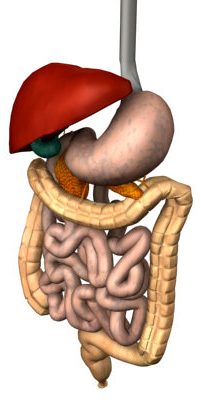Team:Imperial College London/Stomach
From 2009.igem.org
JamesField (Talk | contribs) (→Human Digestive Proteases:) |
JamesField (Talk | contribs) (→Human Digestive Proteases:) |
||
| Line 1: | Line 1: | ||
{{Imperial/09/TemplateTop}} | {{Imperial/09/TemplateTop}} | ||
| - | =<b> | + | =<b>Polypeptides & The Stomach:</b>= |
[[Image:Digestivesystem.jpg|100px|left]] | [[Image:Digestivesystem.jpg|100px|left]] | ||
| - | The stomach | + | The stomach is the first point at which polypeptides are broken down. It is here that large polypeptides are broken down into peptides. This process broadly involves two steps. First polypeptides are denatured by stomach acid, which causes them to open up. Subsequently, these denatured polypeptides are attacked by the protease pepsin. Small peptides leaving the stomach are later broken down into amino acids once they enter the duodenum. |
{{Imperial/09/Division}} | {{Imperial/09/Division}} | ||
| - | |||
| - | |||
| - | |||
| - | |||
===Pepsin=== | ===Pepsin=== | ||
| Line 18: | Line 14: | ||
One of the enzymes that we are showcasing is phenylalanine hydroxylase (PAH) (as a treatment for PKU). If this enzyme was simply swallowed in an unencapsulated form it would be cleaved in 146 places by pepsin in the stomach. | One of the enzymes that we are showcasing is phenylalanine hydroxylase (PAH) (as a treatment for PKU). If this enzyme was simply swallowed in an unencapsulated form it would be cleaved in 146 places by pepsin in the stomach. | ||
| - | Click on the perform button to see a simulated digestion of PAH by pepsin. Alternativly, paste in your own sequence to see if it would be a good candidate for encapsulation. | + | Click on the perform button to see a simulated digestion of PAH by pepsin. Alternativly, paste in your own sequence into the box below to see if it would be a good candidate for encapsulation. |
<html> | <html> | ||
Revision as of 15:27, 14 October 2009

Polypeptides & The Stomach:
The stomach is the first point at which polypeptides are broken down. It is here that large polypeptides are broken down into peptides. This process broadly involves two steps. First polypeptides are denatured by stomach acid, which causes them to open up. Subsequently, these denatured polypeptides are attacked by the protease pepsin. Small peptides leaving the stomach are later broken down into amino acids once they enter the duodenum.
Pepsin
Pepsin is a powerful protease that cleaves at the N-terminus after aromatic amino acids such as phenylalanine, tryptophan, and tyrosine. The optimum pH of pepsin is from 1.5 to 2, at a pH of above 5 denaturation occurs. This means that pepsin is only functional in the acidic environment of the stomach.
One of the enzymes that we are showcasing is phenylalanine hydroxylase (PAH) (as a treatment for PKU). If this enzyme was simply swallowed in an unencapsulated form it would be cleaved in 146 places by pepsin in the stomach.
Click on the perform button to see a simulated digestion of PAH by pepsin. Alternativly, paste in your own sequence into the box below to see if it would be a good candidate for encapsulation.
 "
"




